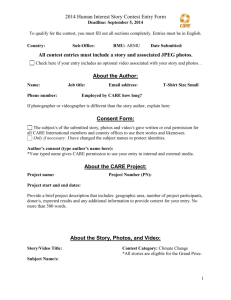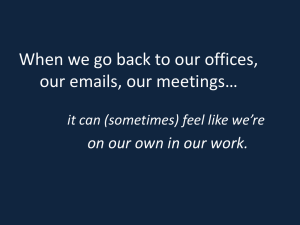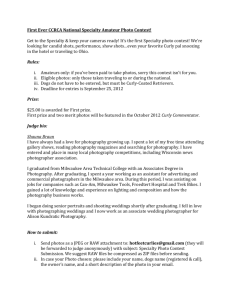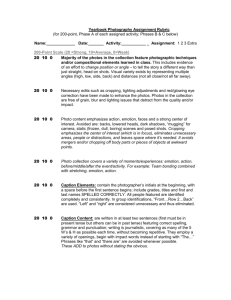Human-Interest Story Contest Instructions English
advertisement
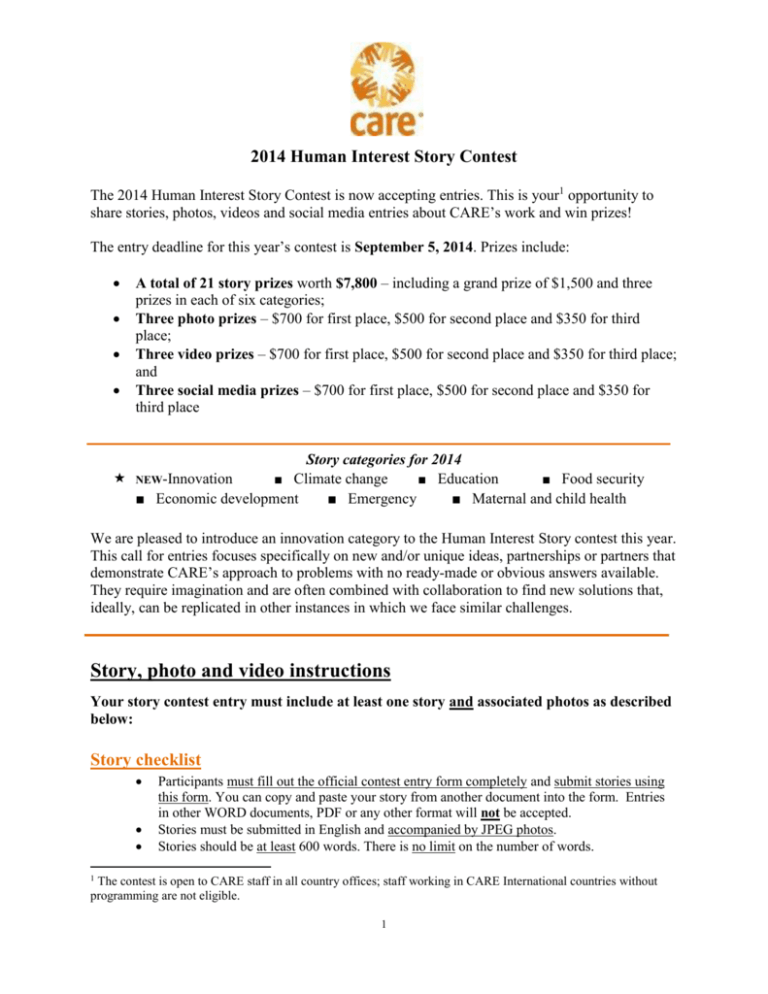
2014 Human Interest Story Contest The 2014 Human Interest Story Contest is now accepting entries. This is your1 opportunity to share stories, photos, videos and social media entries about CARE’s work and win prizes! The entry deadline for this year’s contest is September 5, 2014. Prizes include: A total of 21 story prizes worth $7,800 – including a grand prize of $1,500 and three prizes in each of six categories; Three photo prizes – $700 for first place, $500 for second place and $350 for third place; Three video prizes – $700 for first place, $500 for second place and $350 for third place; and Three social media prizes – $700 for first place, $500 for second place and $350 for third place Story categories for 2014 NEW-Innovation ■ Climate change ■ Education ■ Food security ■ Economic development ■ Emergency ■ Maternal and child health We are pleased to introduce an innovation category to the Human Interest Story contest this year. This call for entries focuses specifically on new and/or unique ideas, partnerships or partners that demonstrate CARE’s approach to problems with no ready-made or obvious answers available. They require imagination and are often combined with collaboration to find new solutions that, ideally, can be replicated in other instances in which we face similar challenges. Story, photo and video instructions Your story contest entry must include at least one story and associated photos as described below: Story checklist Participants must fill out the official contest entry form completely and submit stories using this form. You can copy and paste your story from another document into the form. Entries in other WORD documents, PDF or any other format will not be accepted. Stories must be submitted in English and accompanied by JPEG photos. Stories should be at least 600 words. There is no limit on the number of words. 1 The contest is open to CARE staff in all country offices; staff working in CARE International countries without programming are not eligible. 1 2014 Human Interest Story Contest Stories should be about participants in ongoing/current projects. Stories will be judged based on content (answering who, what, when, where, how and why) and relevance to the story category. Photo checklist Photos must be accompanied by an official contest entry form and story. Photographers must use a digital camera and photos must be submitted in high quality/resolution JPEG format. High resolution images must be a minimum of 640 pixels on the shortest axis. There is no limit to the photo file size. Leave photos in their original file size and do not use camera phones. The story, photos and video for your entry will not be accepted if your photos are printed images or inside a Word document. Entries should include photo captions with the photo number and name of the photo subject in the photo captions section of the official contest entry form. Photos will be judged based on the communication value of the content (how well it illustrates relevant details in the story, deepens understanding or evokes a personal connection to the subject), the composition and the technical acceptability. Your entry can also include a video related to your story and photos as described below: Video checklist Videos must be related to a story and submitted with an official contest entry form. Use the digital flip video camera from your main country office. You can only submit raw/unedited digital video footage directly off the camera. Do not compress or alter the raw footage from the camera in any way before sending. No previously edited videos will be accepted! Do not send along authored DVD files or DVDs of videos that have already been produced. Total video footage submitted must contain a minimum of 20 minutes of footage. You must submit at least 10 action scenes of the subject/s featured in the written story. You must use a wide, medium, and close-up angle for each scene. There are suggestions for shots in the “Guide to Making a Winning Video” section below. If necessary, have your subject repeat actions so that you can capture all angles. You must submit a minimum of three interviews from your subject, project participants, CARE staff, or people discussing the subject of the story or CARE program. If your footage wins, you must be available to help the Video Production unit translate the interviews, as well as stay in contact with the Video Production team in case further help or information is needed to produce your piece. Videos will be judged on content and the usability and quality of the footage, or how effectively the editor can piece together a story from the raw footage provided. While 1st, 2nd, and 3rd place video winners are chosen, only the 1st place winner will have their footage edited into a finished piece. 2 2014 Human Interest Story Contest Social Media instructions Social Media checklist Participants must fill out the contest entry form completely Social media proposals can be submitted separately from the story, photo and video entries. Proposals can, but do not need to include a human interest story. Entries must be in English. Photos must be submitted in jpeg format Social media entries will be judged on the emotional impact and representation of CARE’s work depicted by the photo or video and accompanying caption. The winners’ photos or videos will be showcased on CARE’s Facebook page and Twitter feed and potentially other social media channels. Other notable entries may be featured as well. CARE currently has a social media reach of more than 721,500 connections, and it is growing every day. How to submit your entries 1. Complete the attached entry form fully and accurately, and insert the story text in the indicated field. Do not insert any photos inside the Word document. 2. Prepare any accompanying photos as separate JPG files in their original camera file size (minimum dimensions 640x640 pixels). Do not compress these unless the files are extraordinarily large. Name the files as follows: Country_AuthorName_photo_number (e.g.: UnitedStates_JohnDoe_photo_1, UnitedStates_JohnDoe_photo_2, etc.) Reference these file names with full information about the subject, in the Photo Captions section of the contest entry form. 3. Prepare any video according to the same naming format (Country_AuthorName_video_number) 4. Place the above into a folder (one per entry) on your desktop. Do not forget to include the completed entry form inside the folder! 5. Name the folder Country_AuthorName (if you are submitting more than one entry, you can add a number: Country_AuthorName_1, Country_AuthorName_2, etc.) 6. Compress your folder into one zipped file: a. Right click on the folder b. Select “WinZip” c. Select “Add to Zip file…” d. Select “Add” e. A zip file with the same name and in the same location as the folder will be created (on your computer desktop if you saved the folder there). 7. If the completed zip file is 5MB or less in size, you can e-mail it directly to HumanInterestStory@care.org 8. Photos files that are too large to e-mail can be uploaded to the Box server as follows: 3 2014 Human Interest Story Contest a. Navigate to this Web address: https://careusa.app.box.com/signup/collablink/d_1200186621/7adae633601d0 b. Follow the instructions to create a Box account, by entering your name, e-mail, and a password of your choice c. Go to your e-mail inbox where you will find an invitation e-mail from noreply@box.net (this may go to your spam/junk folder), and click on the link to confirm your e-mail address and log in d. Once logged in, you will have access to the folder CARE Human Interest Story Contest 2014 e. Click on the button marked Upload f. Choose Upload Files, navigate to your zipped file, and click Open g. Your file should now upload, and you should see the message: The file [file name] was successfully added to your account h. Send an e-mail to HumanInterestStory@care.org informing us that you have made the upload, and we will confirm that it has uploaded properly 9. For video files that are too large to e-mail, please upload them to the Box server as follows: a. Navigate to this Web address: http://www.box.net b. Enter username: video@care.org c. Enter password: VideoUpload2014 d. Navigate to the folder 2014 Human Interest Story Contest e. Create a folder under that with your name and country f. Click on the button marked Upload g. Choose Upload Files, navigate to your video, entry form and story files and click Open h. Your file should now upload, and you should see the message: The file [file name] was successfully added to your account i. Send an e-mail to HumanInterestStory@care.org informing us that you have made the upload, and we will confirm that it has uploaded properly 10. If you have limited Internet bandwidth you may not be able to upload very large files (especially video). If this is the case, you may burn the files to DVD, and send to us via pouch. Please include the completed contest entry form both burned on the DVD and as an enclosed printout. The address is: CARE USA Human Interest Story Contest c/o PSI 151 Ellis Street Atlanta, GA 30303 USA (Phone: +1 404 979 9272) 11. Do not hesitate to get in touch with any questions: HumanInterestStory@care.org 4 2014 Human Interest Story Contest Contest tips The following provides suggestions for writing human interest stories, taking photos and making videos. Remember to be creative and think outside the box! Writing a quality human interest story The story you write about project participants is the most important story CARE has to tell. You are in the field implementing CARE’s projects and interacting with our participants, who are the reason that people support CARE. We want to hear and share their story! A good story gives readers an opportunity to see, hear and feel someone else’s experience. It educates readers about conditions in communities where we work and what causes those conditions. Finally, a good story illustrates how CARE helps communities confront the causes of poverty and improve the lives of individuals, families and communities. Select and interview the most interesting girl, woman or family participating in the project. Look for a good story teller! Pretend you are meeting the participant for the first time. Think of questions you would ask someone if you wanted to know them better. Collect as much information on their personal history as possible and try to learn their opinions and feelings. Your story should share CARE’s work through the experience of one project participant and her family. It does not have to be a “success story”, but should feature the problems CARE is addressing. The best stories are about a person, family or small group who CARE can help or has directly helped. Direct quotes and details, such as the names and ages of all people featured in the story, are very important. When possible, tell the story in the first person, as if the project participant were writing the story herself. Good stories answer the basic questions: who, what, why, when, where and how: Who is the participant? Name, age and livelihood? What does she look like? How does she dress? How many people are in the family? What are their names and ages? Is this family typical of the whole community? What is the problem she faces and what project does she participate in? What does she do in the project? What is her day-to-day life like? Why does she have this problem? Why is the CARE project important to them? Why did CARE become involved in the area? Encourage participants to tell you in their own words. When did the CARE project start? When did the participant become involved? Where does the participant live? Describe her home, village, environment, etc. How has the participant’s life changed through involvement with the CARE project? How has her family’s life changed? Her community’s life? Ask the participant to compare life before the project and life now, or ask how she anticipates her life changing. The story does not need to have a clear resolution and can be about an ongoing problem. When preparing for your interview, consider the following: Is the person I am interviewing comfortable sharing her story? Explain why CARE is interested in her story and how it might be used. 5 2014 Human Interest Story Contest Do your research and have a list of questions, but don’t worry if your conversation strays from those questions. Follow up on interesting or unexpected information. Don’t be afraid of silence – give people time to think about their answers. Asking them to repeat answers is fine. Take notes on your surroundings and be observant. o What are the conditions you see in the field? What causes these conditions? o What do the villagers say about their lives and their needs? What kind of obstacles do they face? What are their hopes? o Take notes on the subject’s environment appearance, gestures, and facial expressions. When you begin to write your story: Pretend you are speaking to a friend. What would you tell them about this participant and your project? You are telling a story, not writing a report or preparing a presentation. Do not be too concerned about how you tell your story. Concentrate more on what you are saying. Include the participant’s thoughts and the basic facts about the project. Include descriptive details, especially about what the village or region was like before the CARE project and what it is like now. Be sure to include powerful quotes that tell the story in the subject’s own words. Portray CARE’s work as effective problem-solving for the long-term. Explain the causes of poverty and how they are being solved. Demonstrate how CARE acted as a partner, mentor and team player. Include lessons learned by the community or CARE. How will the project/success be sustained and replicated? Remember, quality matters more than word count. Have fun and get creative! Taking quality photographs ● ● ● ● ● ● ● ● Take lots of photos. If you take more photos you’ll get more creative and you and your subject will become more comfortable. Compose your photograph with a primary subject/subjects prominently featured. Capture the subject in action, in a candid moment or in a more relaxed or ‘natural’ pose. Avoid shooting stiff, posed photos where the subject is standing still. Show how CARE is helping the community. Think how you can show, in a positive and empowering way, how CARE projects have helped the individual and/or community. Use natural, outdoor light if available. Early morning and late afternoon offer the best light. If you must take a photograph indoors or in the shade, be sure you are close enough to the subject for the flash to work (usually 6 to 12 feet, or 2 to 3 meters). Get closer to the subject. If you think you are close enough take that picture and then take two steps closer and try again. Change the angle you take the picture from. Stand on a chair to get above the scene or kneel on the ground and shoot up at the subject. Have fun and get creative! 6 2014 Human Interest Story Contest Making a quality video Make sure to keep your hands steady and avoid jerky movements. Though the camera comes with a digital zoom, don’t use it! The digital zoom causes the video quality to deteriorate and also affects the stability of the video. Get physically closer to the subject if you want a close-up. Zoomed video is unusable. Don’t constantly move the camera while shooting. Collect your footage in “video stills” Hold each shot absolutely still for 15 seconds or more before moving to the next shot. 15 seconds of footage can fill 2 seconds of a finished video, but not the other way around! Keep the camera oriented upright; don’t hold the camera sideways. Sideways footage cannot be included in an edited piece. Any footage shot this way is unusable. Video shows the story, but don’t forget the importance of audio. Audio adds emotion and excitement and can offer valuable contextual information. The microphone is on the camcorder. The closer the subject is to the camera, the better the sound will be. Be aware that if you shoot in a place with a lot of background noise it is likely that your subject's voice will be drowned out, so pay attention to your surroundings, especially in an interview situation. Get the camera as close as possible to the source of the audio. To capture the best audio, do not talk while shooting, unless you are conducting an interview. If you are holding the camera and talking your voice will drown out all other audio. Avoid taping your video in dark places. You will always get the best footage when you have lots of light – indoors or outdoors. Suggested Scene List: Shoot at least 10 scenes applicable to your story. This list provides suggestions for your scenes. Get creative, but remember you need a wide, medium and close up of each scene. Get subject/s to repeat actions to get the three camera angles required (see below). 1. Exteriors of village or town. 2. Exteriors of house where subject lives or works. 3. Interiors of house, job, or school where subject spends time in. 4. Shots of subject/s walking. 5. Subject/s performing daily tasks like cooking, cleaning, studying, playing etc. 6. Subject/s interacting with others. 7. Subject/s participating in school, work, or a meeting. 8. Subject/s with family or friends. 9. Shots of people in the community going about their daily lives. 10. Include three interviews about your story from your subject, project participants, CARE staff, or anyone else that can comment on the project or your subject. All three shot angles must be represented for each scene. That means, if you’ve shot the 5 scenes correctly you should have at least 15 scenes total. Get creative and expand upon this to fulfill your 15 minute minimum! 7 2014 Human Interest Story Contest Wide shot - establishes the scene. Medium shot - gives more intimacy, focuses on one subject. Close-up - for emotion and direct connection to what is being said or done. Providing quality photos and video for social media What is social media and what does CARE use it for? Social media is an online channel where people can interact, tell stories and share information in real time. CARE is active on nine social media channels, primarily on Facebook and Twitter, where we share stories, photos and videos about our life-changing work around the world, as well as important information about the issues related to global poverty. On Twitter, messages are limited to 140 characters, so we share tidbits of information and links to pages on our website, important articles or photos and videos that showcase our work or bring important issues to light. On Facebook and Twitter, we engage daily with supporters who have questions about the work that we do. Our social connections contact us about a number of reasons – often just to say “thank you” for the work we do – and we do our best to send a personal response to everyone who reaches out. Currently, CARE has a social media reach of more than 721,500 connections, and it is growing every day. Our connections are based all over the world, giving you a unique opportunity to make the work that you’re doing go viral. What makes a good social media photo or video? Photos and videos that elicit a response on social media are emotional and personal. Our constituents on social media have chosen to connect with us because these channels are a place to provide “insider information” – i.e. the stories and images that might not make the national news. It’s a place where people come to feel connected to our work. Think of it more as a conversation you’d have with your friends than a press release you’d write on your website. For example, this is a photo of a toy truck made of garbage that CARE USA’s Paul Towne took while visiting CARE programs in Rwanda. While this isn’t a beautiful photo that you’d want to hang up in your home, it tells an important story about what life is like for the people CARE serves. It’s an intimate detail rather than the bigger picture. And, coupled with the caption, it elicits an emotional response because you can’t help but picture the children who love this toy because they’ve never had anything else to play with. 8 2014 Human Interest Story Contest The caption reads: This is the only "toy" kids in a Rwandan day care program have to play with. Their mothers made it for them out of trash from the local dump. When this was photographed, the children were scooping sand from the ground with an empty cigarette package. 10 mothers bring their children to this in-home day care program. The mothers take turns caring for the children while the others work in the fields. This keeps the children safe while allowing their mothers to earn an income. So, your photo or video and accompanying caption should: Tell an emotional and personal story in less than 200 words. If you’re sending in a video, it should be less than three minutes. Showcase an intimate component of CARE’s work. If someone who didn’t know much about CARE came to the field, what would surprise or impress them? Often it’s the small details that make people feel the most connected – not the numbers and big picture summaries. Rather than a photo of just a person or a place, your photo should pique someone’s interest and make them ask, “What is going on and why should I care?” Photos or videos of people in action or unusual looking objects or scenes often accomplish this most successfully. Make sure to tie your story back to CARE. If it represents a component of a CARE program, what is it? If it represents a larger issue, what is CARE doing in your country to help? 9 2014 Human Interest Story Contest Feel free to share your impressions. Use the word “I” – tell us what you think about the picture you are presenting. Direct quotes from country office staff are a great way to connect a foreign audience to the work we’re doing. Be easy to understand. Remember, our social media followers are not your colleagues. They will not understand the complicated aspects of your work, so keep it simple. A good test is to ask yourself if your teenage self would understand what you’re writing. If not, start again. Grab your attention right away. On social media, we are competing with thousands of other people and organizations to get people’s attention. Even if your photo has a cool story to tell, if it isn’t attention-grabbing, people won’t click to learn more. Frequently Asked Questions Q: Who can enter the contest? A: The contest is open to CARE staff in all country offices. Staff working in CARE International countries without programming are not eligible. Public relations and media employed by CARE in country offices are eligible for the contest, but local public relations and media not working for CARE are not eligible. Q: Can I submit just a story, just photos or just a video? A: No. Your entry must include at least a story and JPEG photos. You can submit a video to accompany your story and photos. The following entries will not be accepted: story without JPEG photos, JPEG photos without story, or a video without story and JPEG photos. Q: How does CARE use my story, photos, video and social media? A: CARE International members and your country office may use your entry for the following: Fundraising appeals ● White papers for policymakers and donors Appeals to potential CARE ambassadors ● CARE websites and blogs Project proposals and reports for donors ● Annual Report Speeches by CARE executives ● Radio commentaries CARE’s YouTube Channel ● Newspaper stories and press releases Q: Do we need to assign a Human Interest Story Contest point person for our country office or suboffice? A: This decision is made by to the country office and/or sub-offices. CARE USA recommends assigning a point person in each country office or sub-office to help manage contest entries and ensure that they are successfully entered into the contest. Q: What if my office cannot upload entries via the Internet per contest instructions? A: Save your entry form (including story), photos and video to a DVD. If your office does not have a computer that can burn DVDS, save your entry to a CD. 10 2014 Human Interest Story Contest Q: Is there a limit to the number of entries per sub-office, country office or staff member? A: No, there is not limit. Each sub-office, country office and staff member can submit as many entries as they would like. We especially encourage multiple photos with each story. Remember, each entry must include a story and JPEG photos and can include a video. Q: What if I have other questions? A: Send an email to HumanInterestStory@care.org. 11
